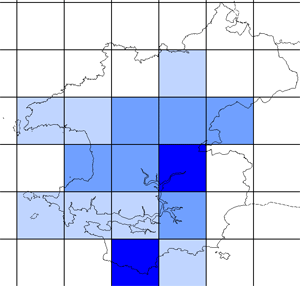Winter visitor and passage migrant
Golden Plovers were evidently much more numerous in the past, for Mathew (1894) noted that "tens of thousands visited the county" in the very cold spring of 1886. Lockley et al. (1949) added that "frosty conditions with north-east winds bring great numbers to Pembrokeshire".
They are frequently seen in wet pastures, mostly, but not exclusively, in the coastal regions. Flocks vary in size up to 1,500 birds but some roosts, such as those at Hook, Garron and Castle Martin ranges, can hold up to about 3,000 birds. The total population at such times is probably about 10,000 birds. Cold spells can bring hundreds of additional birds, many of which pass quickly on, but some stay and this has lead to high mortality when frozen conditions endure; for example over 100 corpses were found around Stackpole following the cold spell in February 1985.
A few arrive during August and September (exceptionally July) and peak numbers are reached between November and February. Spring departure takes place in March and early April and there appears to be a through passage during April and May (sometimes into June) which includes birds showing the plumage characteristics of northern races. Single Golden Plovers and small parties are seen flying in off the sea and coasting during the autumn arrival, and larger parties depart northwards from the estuaries on calm spring evenings. They are sometimes heard passing over at night during the migration periods.
Donovan J.W. & Rees G.H (1994), Birds of Pembrokeshire
 Saturday, October 5, 2013 at 9:36AM
Saturday, October 5, 2013 at 9:36AM  1949 BoP in
1949 BoP in  Golden Plover
Golden Plover 


